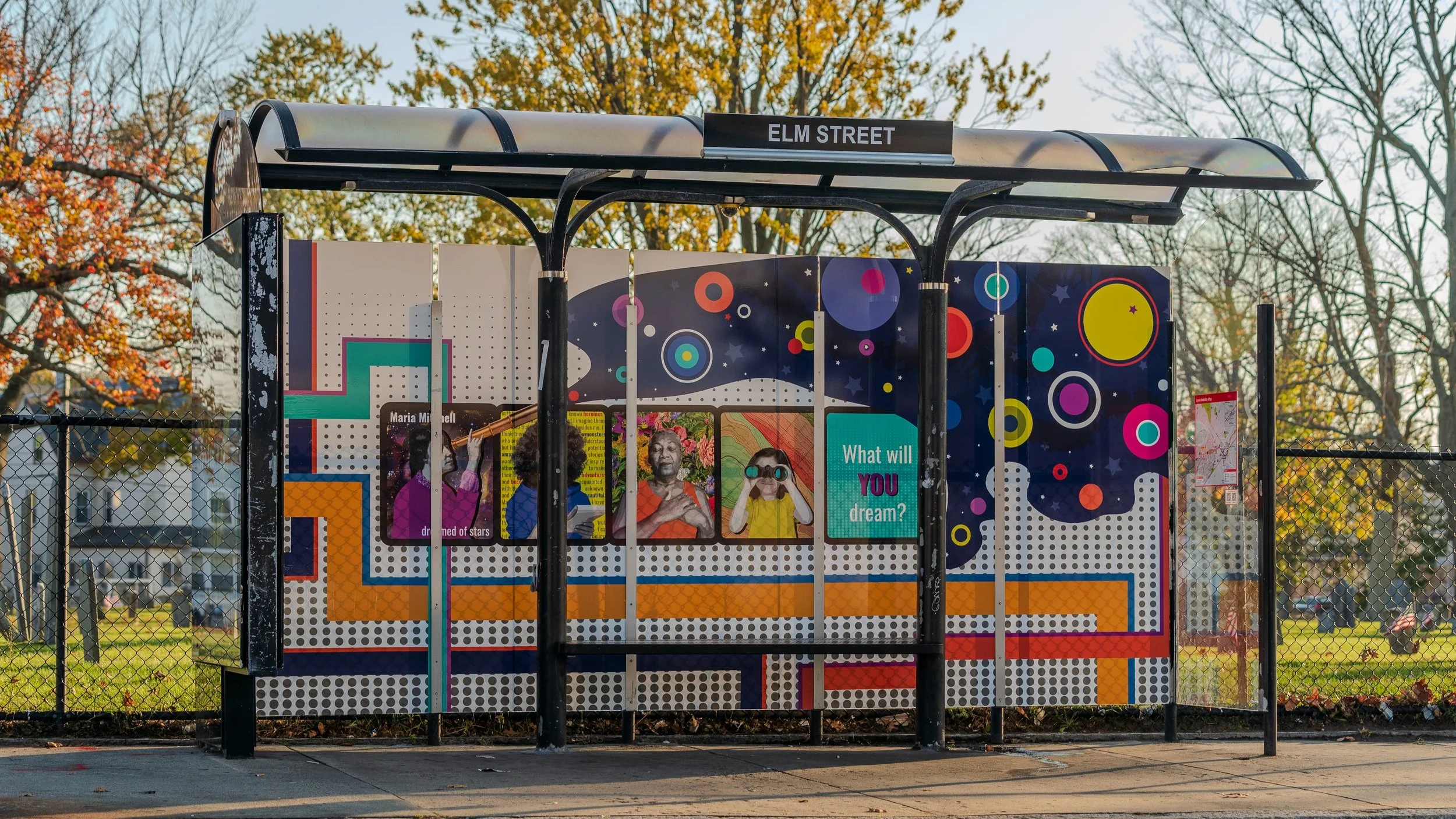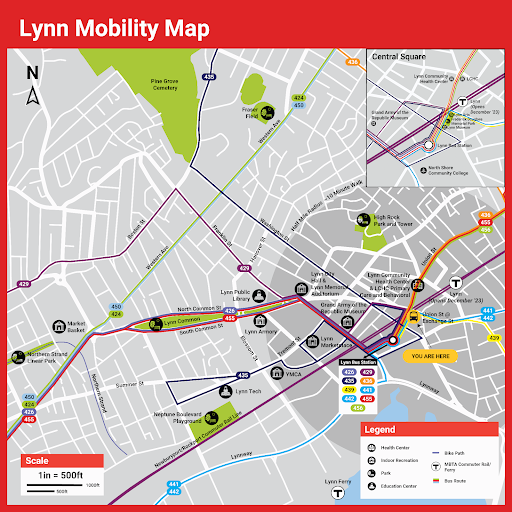BOSTON, December 11, 2023 — The Mobility Hubs team at TransitMatters is pleased to announce the launch of their project, Art on the Move, in partnership with AdHoc Industries, ITDP, Civic Space Collaborative, and the City of Lynn. Art on the Move upgraded seven bus shelters across Downtown Lynn with Mobility Hubs features, including public art, bike racks, mobility maps, live bus schedule QR codes, and wayfinding signage, making the bus experience more pleasurable, easier, and convenient for riders in Lynn.
The Mobility Hub at the Market Square @ Western Avenue bus stop featuring art from Whitney Burdge, a transportation planner and artist whose art is inspired by infographics, data, world travels, and juxtapositions of color and culture.
What is a Mobility Hub?
Mobility Hubs are places that connect different modes of transportation (such as bus, subway, or bikeshare), making transfers between them easy and convenient. They are ideally located close to where people congregate to work, play, shop, and have fun. Whether you are walking, biking or ridesharing to your final destination, Mobility Hubs offer infrastructure that is accessible and user-friendly. Beyond connecting different transit options, Mobility Hubs improve the transit experience with elements such as bus shelters, information displays, and parklets. Mobility Hubs are a necessary component of a well-functioning transit system; they empower people with information and connections to move around freely.
A Mobility Hub is:
Safe. Riders are protected from weather and traffic while they wait. The area is well-lit, with accessible pedestrian crossings and well-maintained sidewalks.
Informative. Countdown clocks let you know in real time when the next bus or train is arriving. Wayfinding signs direct people to nearby destinations.
Pleasant. Mobility Hubs are clean and well-maintained, with trash cans, shelters and benches. Mobility Hubs include refreshing greenery and interesting public art
Why Lynn?
Each Mobility Hub features a Lynn-centric mobility map created by Mobility Hubs volunteer Jerry Zhou.
Before Boston became the hub it is today, the economy of Massachusetts largely centered on manufacturing across various cities, which today are known as Gateway Cities. Lynn is one of 26 Gateway Cities in Massachusetts, which were once industrial centers, giving them a footprint for dense urban development conducive to strong transit networks, but have faced economic and social challenges as industry is no longer the core of the city and thus have a higher need for further infrastructural investment.
Furthermore, Lynn also holds many characteristics that define it as an environmental justice community. All census blocks in our project area have a combination of the criteria that define an environmental justice community: 40% or more of residents are minorities, 25% or more of residents experience English isolation, and the average median household income is 65% or less than the statewide annual median household income. This means that the population in Lynn has a greater need for environmental benefits, such as improved transit corridors.
The bike hitch at the Union Square @ Exchange Street Mobility Hub.
This is especially important because Lynn is currently experiencing heightened transportation injustice with their Commuter Rail station closed. After years of disinvestment and deferred maintenance, the station became dilapidated and closed in October 2022. While riders can take a shuttle bus to Swampscott to board the Commuter Rail, this removes the convenience of rail, creating additional barriers to transportation access. However, understanding the greater need in Lynn for transportation access, the completion of a temporary station just a few blocks away has been expedited, opening several months early on December 18, 2023!
To increase transportation access in Lynn, there have been efforts to expand bike access. The cyclist advocacy organization Bike to the Sea began working on the Northern Strand Community Trail in 1993, which now extends from Everett to Lynn. This active transportation path, equipped with amenities and road-crossing safety features, is set to extend through Downtown Lynn. The Northern Strand has made cycling in and around Lynn safer and more accessible. With the proposed extension running through the Mobility Hubs project site, it was only natural to add cycling infrastructure to support this trend. As a result, the project team installed seven bicycle hitches, one at each bus shelter, all increasing mobility for cyclists in Lynn.
The Mobility Hub at the Union Square @ Exchange Street bus stop featuring art from Ruth Henry, a Boston-based artist who layers color, texture, and poetry into intricate reflections of conflict and possibility. Photo credit: Spenser Hasak
While the need for Mobility Hubs was clear, Lynn was also a perfect candidate as it is a major center for arts. Investment in arts and culture is key to building thriving Gateway Cities and has been particularly successful in Lynn. The city is home to over 80 large-scale murals, artist centers, galleries, museums, and 16,000 sq ft of interactive LED lighting along underpasses and vintage neon art installations to improve the pedestrian experience around Lynn. As art plays a large role in Mobility Hubs by connecting communities to their surroundings, Lynn was the perfect choice for this project, leading to seven art installations completed by local artists. Riders can read more about the artist and their work through artist statement stickers installed on the bus shelters hosting art.
Impact of Mobility Hubs
Lynn is unique compared to surrounding regions. It is the most densely populated area on the North Shore and has some of the highest rates of non-car households, indicating that residents are more likely to use transit regularly. At the same time, much of Lynn's 20 and 21st century infrastructure is geared toward car-centered connectivity, limiting bike, pedestrian, bus, and train access. Currently, major reports detailing future connectivity investments inside of Lynn, including the MBTA Focus 40 Plan (2019), the Lynn Walking and Bicycling Network Plan (2019), the Lynn Transit Action Plan (2020), and the Lynn Safe Streets for People Playbook (2021), outline their own set of priorities and goals, yet focus on how to improve multi-modal forms of transit to establish a more reliable and accessible network. Short-term projects include improving bus routes along congested roadways by adding designated bus lanes, renovating bus shelters and benches at stops, adding all-day service along the Newburyport/Rockport Line, renovating Lynn’s Commuter Rail station, developing a bike share program, and implementing safer bike and pedestrian design along priority routes. Long-term projects include the expansion of the Blue Line to Lynn, reimagining the local bus network, creating transit-oriented development for additional affordable housing, and creating a neighborhood greenway in conjunction with local community members.
While comparatively small in size, this Mobility Hubs project helps reach the goals outlined in the above plans by making mobility more accessible. Art improves the rider experience, wayfinding signs enable mobility throughout Lynn, live bus schedule information makes waiting for the bus less strenuous, bike racks allow cyclists to easily transfer modes, and mobility maps make local navigation, whether by foot, bike, bus, or Commuter Rail, easier. To learn more about how to create Mobility Hubs in your community read TransitMatters’ Mobility Hubs Toolkit, and read more about Art on the Move in ItemLive, Boston Business Journal, and WBZ.





